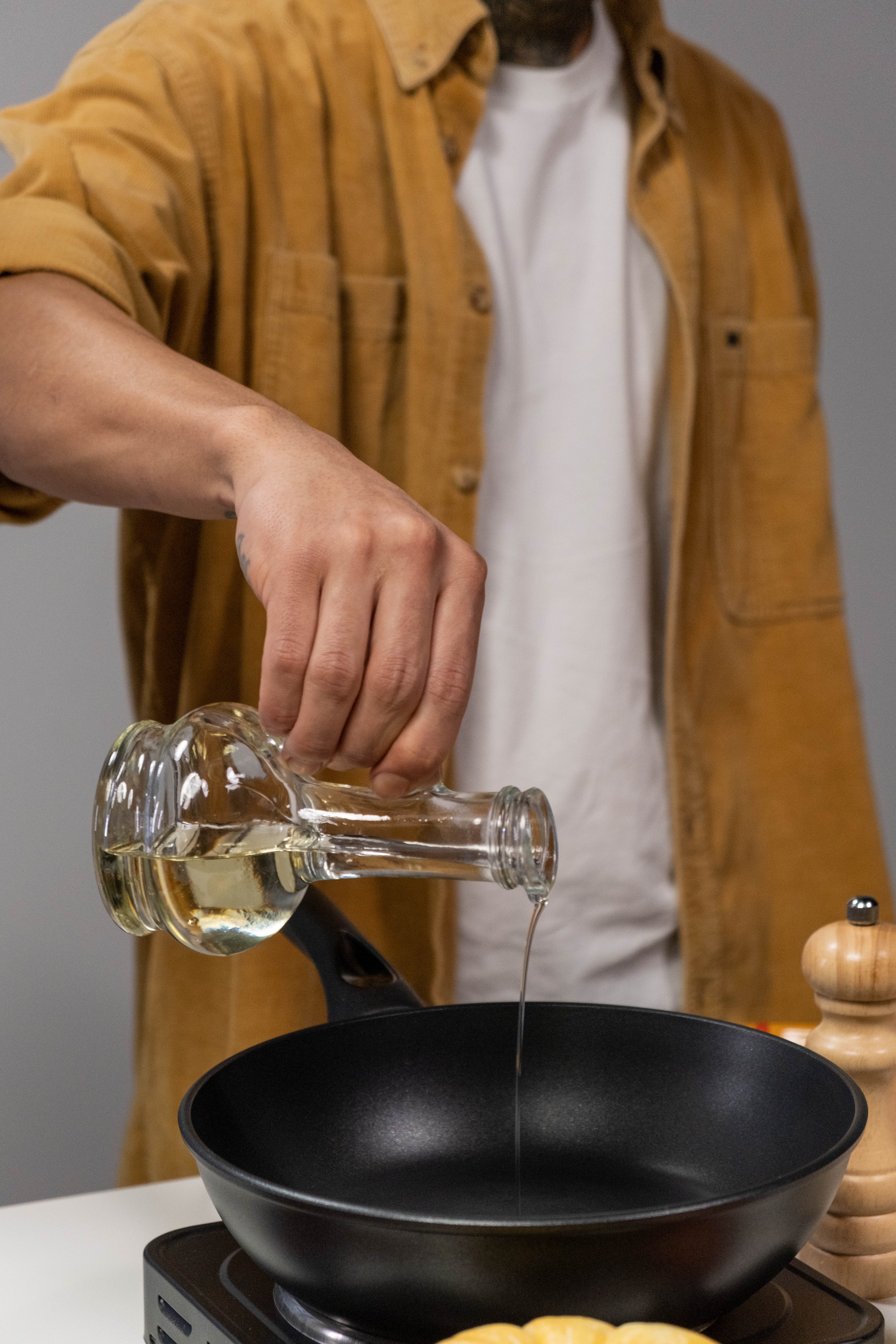Reheating Cooking Oil: Risks involved and Tips to Avoid Used Oil
6 minuteRead

Have you ever paid attention to the cooking oil you use, and how many times do you end up reheating the same oil that had been earlier used for deep-frying or pan-frying? It is important to raise awareness about this highly dangerous yet often looked-over kitchen practice. Reusing cooking oil may happen due to either an excessive amount of food or meal prepping. This common kitchen practice may help you save time and also money, but it can also be the leading cause of the high levels of inflammation in your body. Read on to find out more about some of the dangers linked with reheating cooking oil.
Top health risks you need to be aware of associated with reheating cooking oil
1. The oil becomes more carcinogenic
A carcinogenic substance is that which has the potential to cause cancer. Upcoming research and studies prove the fact that aldehydes - which can become toxic compounds - are produced when you reheat oil. Cooking food with the help of reused cooking oil also promotes the release of free radicals in the body, which ultimately lead to inflammation. Inflammation is the leading cause of most diseases including obesity, diabetes and other heart diseases. High inflammation also puts you at the risk of having lowered immunity, which makes you a lot more prone to infections.
2. It increases the LDL cholesterol amounts in our body
Food that has been cooked in oil which is black or smoked and gets reused and reheated throughout the day can increase the level of LDL (also known as bad cholesterol) in the body. High levels of LDL cholesterol has been proven to increase risks of chest pain, heart disease and even stroke. Avoiding reused cooking oil goes a long way in preventing cholesterol-related problems.
3. High amounts of acidity
If you find that annoying, uncomfortable sensation of burning in your stomach and throat bothering you way more often than it should, then it is quite possible that the reheated oil being used to cook the food you eat is the culprit. Keep away from the roadside hawkers that sell you all that junk food, and also try to avoid eating deep-fried food if you notice yourself experiencing more acidity than usual. If you begin to see some changes in reducing your acidity levels, then you have your answer - reused cooking oil is the one to blame!
Some other health risks involved with consuming food that has been cooked in reused oil include:
- Obesity
- Weight gain
- Diabetes
- Heart disease
How Do I Reduce The Usage of Reheated Cooking Oil?
1. Switching to fresh, home-cooked food
Home-cooked meals are the freshest and healthiest variety of food you can put inside your body. Cooking at home gives you the agency to decide which ingredients go into your meal, including carbs, protein, fats, fibre, and obviously the cooking oil. It helps you construct a balanced diet that aids good health and promotes weight loss. It also empowers you to make a decision regarding whether you would like to reuse cooking oil, and also how many times!
2. Cooking Food in Small Quantities
This is a highly effective way of reducing excess cooking oil. Calculate in advance the amount of food you need for a particular meal. Not only does this go a long way in avoiding food wastage, but also help you decide the amount of oil you need. It also encourages you to cook fresh food as frequently as possible, and even helps you practice portion control, which in turn promotes weight loss!
3. Carry home-cooked food when travelling or going out
There are obviously certain unavoidable times during which it is simply unavoidable to eat out. But, you can try and work on reducing the number of times you have to eat out! Meal prepping helps a lot in this situation. On a day that you know, you will be travelling instead of being at your regular workplace or at home, carry some home-cooked meals with you. This will help you stick to your diet regimen and also prevent unnecessarily eating food outside that has most probably been cooked in reused oil.

Additionally, if you have certain preexisting conditions, such as Alzheimer’s, high BP, heart disease, or any other disease that is prominent in your family, it provides you all the more reason to avoid the usage of reused cooking oil. It will only further worsen the conditions that are inflammatory in nature.
How do I know that the oil I’m using has become toxic?
The “smoke point” of the oil is when you first start to see wisps of smoke on the surface of the hot oil while cooking. It is much more important than it seems - because it indicates that the oil is ready to fry your food in, but also that the oil is beginning to lose its properties and become toxic.
When this happens, the problem that arises is the formation of long-chain fatty polymers, that are known to carry long-term risks of cardiovascular accidents. Reused oil is also capable of spoiling the food in which it gets absorbed, and turn into strange colours and flavours.
How do I know when the oil should no longer be reused?
The deposit that collects at the bottom of the fryer or pan is one of the most telling signs that indicate the fact that the oil needs to be changed, STAT! But, if you have been religiously filtering and cleaning it, you won’t be able to take help from this indicator. A key to understanding the same is the appearance of bubbles while you cook. More bubbles signal clean oil!
So, how do I go about the frying process? Also, which oil do I use?
Obviously, it is the better and healthier option to fry with clean, unused oil. However, if you do not usually fry foods that are high in sugar content, there is a defined margin for reuse, that can be quite wide - depending on the situation. For instance, the situation can include factors such as the type of oil being used for frying, the frying temperature as well as the utensils that are being used for frying.
It also comes in handy to keep in mind that the “smoke point” of the oil automatically reduces if the oil you use is cleaner. Research shows that one of the most recommended oils for frying include olive oil. Due to the fact that sunflower oil is known to generate a very high amount of toxic aldehydes in very little time, it is less preferred while compared to olive oil. If you find yourself having exceeded the smoke point in the first use itself, it is discouraged for reuse on another occasion, regardless of the type of oil.
Another very important factor to consider is the food that is being fried. It needs to be quite dry before you dunk it in the hot oil, and therefore, it is advisable to leave a frozen item at room temperature to thaw for a long time before introducing it to the hot cooking oil. This is because the presence of water contributes to the decomposition of the oil. After you are done with cooking, always remember to filter the oil and store it in a jar, in a place that is free of humidity and direct sunlight.
What Should I do With The Used Oil I Have At Home?
Think twice before you make a decision regarding what you want to do with the oil you have just used for cooking. This is because throwing it in the sink should be the very last option on your list! According to some research, almost two-thirds of the oil that is used in Spain ends up in the sewers (which is almost about 120 million litres of cooking oil). This practice is extremely detrimental to the ecology and causes some serious problems including clogged pipes, a lot more energy usage in treatment plants, pollution (even one litre of oil contaminates about 100,000 litres of water), and so on and so forth. The best foot forward for you to put would include keeping an empty water bottle at home in which you can fill your reused oil. After doing this, you can leave them in specific containers of clean spots.
Our Recommendation - 3 simple pieces of advice to stick by
- If you are somebody who is keen on taking care of not only your own health but also of the planet, we recommend not to reuse the same cooking oil more than three times. This is because, after the third frying, the oil has begun to disarm its caloric potential.
- Always keep in mind that used cooking oil is never meant to be chucked down the sink. It doesn’t contribute towards keeping either the city or the planet clean. Instead, try and find a clean point every once in three months to deposit the oil there.
- Keeping an oil container handy for each different food item is a good technique that helps keep the oil as healthy as possible. For instance, when you cook french fries, reserve a jar for that oil, and keep another for fish, and yet another for some other coated food.
Write, Record and Answer! Consume Unlimited Content! All you need to do is sign in and its absolutely free!
Continue with one click!!By signing up, you agree to our Terms and Conditions and Privacy Policy.












